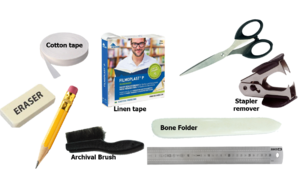Processing of Transferred of Public Records and Archives
Contents
Introduction
Processing of Transferred of Public Records and Archives is one of the activities under the purview of Archives Management Division, Depository Services Sector.
The record preservation process is the most important element in the entire records and archive conservation operation. The purpose of the preservation of archival records is to extend the life of the use of the archival materials for research purposes. Archiving of archive materials is to reduce the risk of damage and slow down records impairment. Prescriptive preservation is a way of identifying and treating or copying damaged records/materials to be conserved for access or reference to users.
Pustaka Negeri Sarawak has established preservation procedures for the preservation of departmental records that are to be transferred to State Records Repository, Pustaka Negeri Sarawak. Each of these processing steps should be followed to meet the standards before being stored and preserved in the Repository.
The guideline video for this process can be access here and it known as e-preservation: https://www.pustaka-sarawak.com/apps/epreservation/ and Modul Pemprosesan Fail Pindah Oleh Jabatan can be view at this link https://www.youtube.com/watch?v=bSpVOqNtuH4&list=PLrCnBpYDEv-Ix5vVH_S6Bd78Qo_YfEjm8&index=17
Preparation for Processing of Records and Archives
1. Dress Code
- Personal protection must be ensured before undertaking the processing of records and archives.
- Personal protective equipment such as protective gowns and nitrile protective gloves and face mask will complete the personnel protection and at the same time prevent the cross-contamination onto other records or documents.
2. Preparing the Area
- Provide essential space for cleaning process of records and archives.
- Food and drink are not allowed.
- The space for processing of the records and archives is divided into three areas:
- Dirty File Area.
- Cleaning Area.
- Clean File Area (TRAY).
3. Tools
• Cotton Tape
• Linen Tape
• Pencil
• Eraser
• Archival Brush
• Scissor
• Stapler Remover
• Bone Folder
• Ruler
Steps for Processing of Records and Archives
1. Checking
- Remove the files from the box and place it on the Dirty File Area.
- Check each title and file number based on the list provided in the Borang Pemisahan Rekod before writing down the start date and end date of the file on the Description Label.
2. Numbering
Write the numbers behind each record sheet with a pencil in descending order from the last page until the front page for Numbering Process. Refer to File Arrangement Table below when doing the Numbering process.
| No. | Material | Action |
|---|---|---|
| 1 | One sheet of paper | counted as one page. |
| 2 | Booklet (Ring Binding) | Open the plastic cover, the ring binding and count every sheet of the booklet as one page. |
| 3 | Brochure |
|
| 4 | Book |
|
| 5 | Photos | Put in the envelope, and count each photo as one page. |
| 6 | Envelopes and photos |
|
3. Remove foreign elements
All foreign elements shall be removed from the file to prevent the damage to the files. Refer to the table below when doing the removing the foreign element.
| No. | Foreign Elements | Action |
|---|---|---|
| 1 | Old sellotape | The old tape must be removed because it contains acid and can damage the papers. Under certain circumstances, do not remove the old tape if it affects and damages the files or papers. |
| 2 | Stapler, iron, screw | Use stapler remover to open any iron element attached in the files. |
| 3 | Rope | Cut the rope using scissors to prevent the damage to the file. |
4. Cleaning
- The files to be cleaned should be cleaned in the Cleaning Area using an archival brush.
- It is recommended to clean the file by brushing the file from bottom to above. Do not clean the file by brushing it to the side to prevent the dust move into other files.
- Use bone folders to straighten/flatten the folded paper surface. Be careful when flattening the folded surface to prevent the file being damaged especially the old files that are easily torn.
- Tear surfaces to be repaired using archival linen tape.
- If the surface of the paper has holes, make sure both top and bottom surface of the paper to be repaired in order to prevent it attached with other paper.
5. Rearrange
Once the files that have been processed in the Clean File Area are finished, the files must be rearranged according to the original order that has been made through the "Numbering Process".
6. Bind Files
Files that have been cleaned up must be bind using cotton string.
- Tie the files by intersecting them to ensure that the file bonds are stable and sound.
- Make sure the bond is not too strong to damage the file.
- Use A4 Sized paper to be a liner/layer and tied with the file.
7. Measurement
- Each file should be measured in centimeters and measured through the bottom up to the file.
- To ensure the height of the file can be calculated correctly, the ballast shall be used to ensure there is no space in the file.
8. Storage
Keep and arrange the file into a clean archive box and make sure every file that been placed into the archive box is suitable with the size of the archive box.
